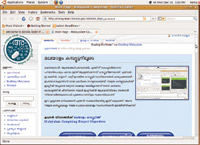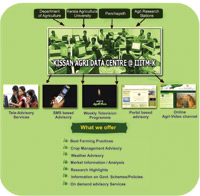e-Governance is gaining wide currency in India with the Government of India giving it formal acceptance through policy documents, primarily the National e-Governance Plan (NeGP), 2006. The NeGP mainly comprises of the Central Mission Mode Projects (MMPs), State MMPs and the Integrated MMPs. The State MMPs are primarily those sectors which have greater public service delivery and interface and include Agriculture, Commercial Taxes, e-District, Employment Exchange and Land Records, to name some.
Even before the NeGP, the Government of Kerala was a front-runner in implementing many a citizen-friendly e-Governance projects that served to improve performance, efficiency, quality of service and reduce costs, thereby enabling better utilisation of limited resources. The government is committed to fulfilling the aspirations of the state by sustaining the position of leadership in economic and social development. To achieve this end, it recognises the significance of use of Information and Communication Technologies (ICTs). In its IT Policy 2007, the government has declared its intention to bring about a user-friendly e-Governance system and envisages optimum utilisation of resources in the e-Governance spectrum.
e-Governance Infrastructure

All e-Governance applications run on core ICT infrastructure. Though they do not create value by itself, they are essential for the delivery of other ICT applications. The Government of Kerala has taken a lead in setting up three major e-Governance ICT infrastructure projects: the State Data Center (SDC), the Kerala State Wide Area Network (KSWAN), and a network of common service centers in the form of Akshaya centres all over the state. Encouraged by the response generated to the 5000 sq.ft State Data Centre that hosts over 100 government applications, the Government of Kerala has commissioned another Data Centre that will be operational by 2010. The KSWAN has created a common communication infrastructure, linking some 1660 government offices in the state. Akshaya, launched as a pioneering initiative to promote e-Literacy in 2002, has now grown into a network of 2200 centres all over Kerala that provides e-Literacy along with other citizen services including payment of utility bills, educational programmes besides cash transfer facilities. In fact the timely provision of ICT infrastructure has enabled 90 percent of Kerala villages to have broadband access.
 As part of the other ICT infrastructure, the government has set up facilities including video-conferencing facility, citizen’s call centre, official email facility, e-Procurement, state spatial data infrastructure, service delivery gateway, public key infrastructure and mobile infrastructure. While effective time and location, independent quick communication and decision making has been the objective behind video conferencing and official email facility, public key infrastructure through digital signatures has served to lend authenticity to email communications. The citizen’s call centre has enabled easy and effective government to citizen interaction and information delivery. The call centre database contains details of as many as 35 Kerala government departments/projects. The mobile infrastructure has been created to leverage the favourable tele-density levels of Kerala. One of the projects that uses the mobile platform is Dr. SMS that delivers health-related information through a short service message.
As part of the other ICT infrastructure, the government has set up facilities including video-conferencing facility, citizen’s call centre, official email facility, e-Procurement, state spatial data infrastructure, service delivery gateway, public key infrastructure and mobile infrastructure. While effective time and location, independent quick communication and decision making has been the objective behind video conferencing and official email facility, public key infrastructure through digital signatures has served to lend authenticity to email communications. The citizen’s call centre has enabled easy and effective government to citizen interaction and information delivery. The call centre database contains details of as many as 35 Kerala government departments/projects. The mobile infrastructure has been created to leverage the favourable tele-density levels of Kerala. One of the projects that uses the mobile platform is Dr. SMS that delivers health-related information through a short service message.

Standardisation
As part of standardising government applications, as advocated in the IT Policy to create a user-friendly system, the Government of Kerala has launched several common application platforms. These include the Service and Payroll Repository of Kerala (SPARK) that is an integrated repository for payroll management of government employees, MESSAGE that digitises the work flow and improves efficiency by reducing time lags in physical movement of files and IDEAS that enables easy file tracking. For generating uniformity across all government websites and to facilitate real-time and easy updation, the project to migrate all government websites to the content management framework has been launched. The government has also adopted the Universal Access Strategy, by way of which there would be bilingual websites besides having provisions for the differently-abled population through options like ‘Read with your Ears’. Facilitating bilingual online content is the Malayalam Computing project that makes available compatible Unicode Malayalam font in computers. Again in keeping with aspects of standardisation, almost all e-Governance projects of Kerala are based on Free and Open Source Software (FOSS), in line with the official policy of promoting free software.
The government is committed to fulfilling the aspirations of the state by sustaining the position of leadership in economic and social development. To achieve this end, it recognises the significance of use of Information and Communication Technologies (ICTs).
All the projects mentioned under e-Governance Infrastructure and Standardisation are being implemented by the Kerala State IT Mission, the nodal IT implementation wing of the Government of Kerala.
Sector-Specific Initiatives
 e-Governance has also found application in cancer diagnosis and care through OncoNet Kerala, a project of the Regional Cancer Centre, Trivandrum and in information delivery for agriculturists through Karshaka Information Systems Services and Networking (KISSAN), a project developed and implemented by Indian Institute of Information Technology and Management–Kerala (IIITM-K), Trivandrum for the Department of Agriculture. Serving to create a transparent paddy procurement mechanism is the Paddy Procurement System of the Kerala State Civil Supplies Corporation that has found favour with 50,000 farmers and 60 rice mills, who account for 250,000 metric tonnes of crop every year. Other sector-specifi c projects will strong spillover benefi ts are complete land re-survey of the State through Bhoomikeralam, crime reporting via MMS; a project for the Kochi Police. In a matter of honour, NASSCOM has listed the agency among India’s top innovators.
e-Governance has also found application in cancer diagnosis and care through OncoNet Kerala, a project of the Regional Cancer Centre, Trivandrum and in information delivery for agriculturists through Karshaka Information Systems Services and Networking (KISSAN), a project developed and implemented by Indian Institute of Information Technology and Management–Kerala (IIITM-K), Trivandrum for the Department of Agriculture. Serving to create a transparent paddy procurement mechanism is the Paddy Procurement System of the Kerala State Civil Supplies Corporation that has found favour with 50,000 farmers and 60 rice mills, who account for 250,000 metric tonnes of crop every year. Other sector-specifi c projects will strong spillover benefi ts are complete land re-survey of the State through Bhoomikeralam, crime reporting via MMS; a project for the Kochi Police. In a matter of honour, NASSCOM has listed the agency among India’s top innovators.
Thus in keeping with the e-Governance objectives of Kerala, it has conceptualised and implemented several initiatives that deliver high-quality citizen-focused services.
Be a part of Elets Collaborative Initiatives. Join Us for Upcoming Events and explore business opportunities. Like us on Facebook , connect with us on LinkedIn and follow us on Twitter, Instagram.











